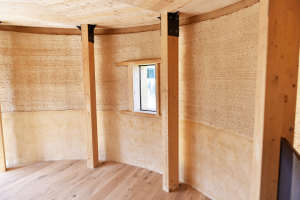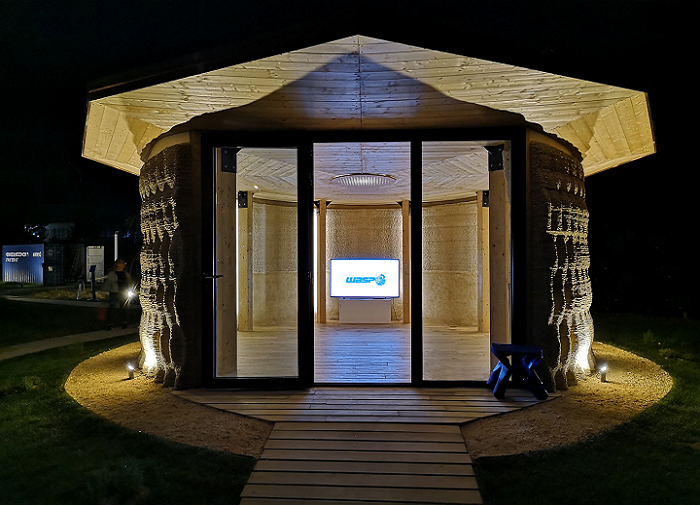WASP Launching Long-Term ‘3D Printing for Sustainable Living’ Construction Project
In September, WASP, or the World’s Advanced Saving Project, debuted its new Crane construction 3D printer, in Italy. It’s actually a modular 3D printing system, or “infinity 3D printer,” with different configurations to choose from, and was presented to the public in Massa Lombarda, where the 3D printed village of Shamballa is being constructed.
In October, a two-day program was held, starting with a conference titled “A call to save the world,” surrounding the introduction of WASP’s Crane 3D printer and its innovative 3D printed Gaia Module. The livable, tiny 3D printed house is the first structure that the WASP Crane 3D printed, and was made out of actual raw earth, with straw and rice husks added to the interior for insulation.
“Everyone in the world will have a fine, healthy, sustainable, self-sufficient and ecological home for birthright,” WASP wrote in a press release. “The earth is our witness, took form in Gaia.”
Now that the 3D printed architectural Gaia model is complete, WASP is beginning a brand new technological phase “in view of Expo 2020,” and kicking things off in 2019 with a long-term program called “3D Printing for Sustainable Living.”
GAIA represents an important case study for understanding just what’s possible when using 3D printing in the construction industry. The 3D printed earth module is an important part of WASP’s new program, which focuses on developing construction process using digital fabrication and 3D printing in an effort to move towards an all-new concept of building houses.
“As already announced in the conference “A Call to save the World”, WASP runs for a collaboration with partners belonging to every sector, from architectural design to the university research, from humanitarian associations to national ministries, able to fully share the project,” the company wrote. “It proposes a strategic program of constructive activities, expressly designed for on-site 3D printing and developed through the use of local raw materials.”
The program centers around an advanced, eco-sustainable model of construction, especially due to the lower cost and higher interior comfort the walls in the Gaia model provide with their combination of raw earth and natural waste as construction materials.
Some of the partners expected to work with WASP on its new project include a few universities, humanitarian associations, banking institutions and foundations, both public and private authorities, and several ministries, including Education, Health, Environment and Protection of Land and Sea, Infrastructure and Transport, Labor and Social Policies, Foreign Affairs and International Cooperation, Food and Forestry Agricultural Policies and Tourism, and Economic Development.
 The project is based on six main macro-areas, starting with the promotion of human and material resources from the territory. This area features the capitalization of human knowledge, the use of renewable energy sources and materials found on site, the democratization of technology for the purposes of production, and using local manpower, rather than people with advanced training.
The project is based on six main macro-areas, starting with the promotion of human and material resources from the territory. This area features the capitalization of human knowledge, the use of renewable energy sources and materials found on site, the democratization of technology for the purposes of production, and using local manpower, rather than people with advanced training.
The second project area is sustainable construction processes with low environmental impact, including such items as lowering construction costs, CO2 emissions, the use of concrete, and transport operations, as well as using natural waste and better planning out the construction life cycle. Recycled materials, like natural waste from the agricultural chain and rubble, make up the third area, while the fourth is centered around the digitalization of the construction site through features such as digital data acquisition through 3D scanning, site monitoring, using on-site measuring to lower the amount of mistakes, and constantly defining the correct spatial coordinates.
Multi-purposes construction is the fifth project macro-area, which includes coordinating the use of multiple methods of digital fabrication like CNC technology, embedding supply facilities during initial construction rather than after, adding natural ventilation and thermal insulation right onto the walls, and using controlled material deposition to achieve high performance construction. Digital design is the final project area, and will focus on features including integrated design with BIM software, sharing digital contents available on the Internet, using a material optimization algorithm for construction, and making construction projects fully digital.
With this new project, WASP hopes to become a leader in the housing market, due also to its network of collaborators that will help to foster and share the project. The company knows that are some real opportunities in the future for green building, and also plans to develop a new eco-district in order to implement its “3D Printing for Sustainable Living” project goals and set up new constructive strategies that can be replicated in multiple environments.
Discuss this news and other 3D printing topics at 3DPrintBoard.com or share your thoughts in the Facebook comments below.
[Images provided by WASP]Subscribe to Our Email Newsletter
Stay up-to-date on all the latest news from the 3D printing industry and receive information and offers from third party vendors.
Print Services
You May Also Like
3D Printing Grows to $15.9B in 2024 Amid Shifting Industry Dynamics
The global additive manufacturing (AM) market reached $15.9 billion in calendar year 2024, according to “Q4 2024 3DP/AM Market Data and Forecast” from Additive Manufacturing Research (AM Research). Despite a...
3DPOD 247: LJ Holmes, Executive Director for the Center of Advanced Manufacturing and Materials at Harrisburg University
Executive Director for the Center of Advanced Manufacturing and Materials at Harrisburg University, Larry “LJ” Holmes is a pioneer in applying additive manufacturing to defense and other critical sectors. Part...
Thai Startup OsseoLabs to Cut Surgery Time with 3D Printed Magnesium Implants
A patient undergoing mandibular reconstructive surgery typically faces two separate operations: one to place a custom-fit titanium plate and another month later to remove it. But what if that second...
Japanese Advanced Manufacturing Capabilities Grow in Europe with Sodick’s Purchase of Prima Additive
The global economy is currently undergoing a reshuffling in terms of what gets manufactured where. In large part, this trend is being driven by new geopolitical alliances and the need...





























